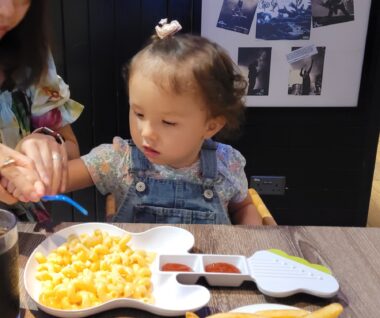Learning the language of our child with AADC deficiency
These interventions helped our daughter make progress with her speech

One minute, it was a slow coo, and the next, a high-pitched scream. It may have sounded obnoxious to a random observer, but for us, it was speech.
It was a long way from where a typical 3-year-old should be, but it was an exciting milestone for us. Our daughter, Rylae-Ann, was born with a rare neurotransmitter disorder known as aromatic l-amino acid decarboxylase (AADC) deficiency. This disease left her with low muscle tone that made typical speech impossible.
Learning to speak

Rylae-Ann Poulin’s mom teaches her how to eat, which is a necessary precursor to developing speech. (Photo by Richard E. Poulin III)
Many muscles are required for speech. Initially, only the tongue and mouth muscles may come to mind. However, the diaphragm, abdomen, and many other muscles are also involved. AADC deficiency makes all of these muscles notably weaker when they need to be strong and coordinated to produce speech.
My wife, Judy, was determined to get Rylae-Ann to talk. Her first steps involved working with our daughter on eating and transitioning to oral placement therapy, a type of speech therapy. This path proved successful, but it wasn’t overnight.
Over several years, Rylae-Ann went from babbling to using words and, eventually, sentences. Again, this was over years. In between all of this training, we still needed to communicate as a family. This is where the crying comes in.
Learning to understand her language
As her parents, we could distinguish between the different wailings, cries, and utterances. Although she couldn’t speak words, Rylae-Ann still very much wanted to communicate with us. Even her eyes told us that.
Instead of getting frustrated or trying to dismiss the cries, we learned to discern her form of speech. Judy was able to understand her crying language very quickly. I associate it with maternal instinct.

Today, Rylae-Ann Poulin enjoys singing songs wherever she goes. (Photo by Richard E. Poulin III)
The evolved language
Today, Rylae-Ann speaks in sentences. However, there is a slight impediment to her speech. To Judy and me, it sounds as clear as day. But for people who meet her for the first time, it is slightly slurred.
She also uses abbreviated sentences most of the time. It’s still very taxing for her to speak as efficiently as a typical child her age, so she has learned to be more precise with her language. For other people, it seems like a riddle.
She still yells and cries sometimes instead of using words, which is still frustrating to hear. Part of this is due to her anxiety, which we continue to work on, but also because it is the foundation of her protolanguage.
Rylae-Ann’s speech has evolved — going from loud cries to singing songs — but there is no mistaking its uniqueness. As parents, we must learn to become fluent in our children’s language. We can support them on their language development journey while also communicating with them. AADC deficiency may rob them of many opportunities, but the desire to communicate is still very much alive.
Note: AADC News is strictly a news and information website about the disease. It does not provide medical advice, diagnosis, or treatment. This content is not intended to be a substitute for professional medical advice, diagnosis, or treatment. Always seek the advice of your physician or other qualified health provider with any questions you may have regarding a medical condition. Never disregard professional medical advice or delay in seeking it because of something you have read on this website. The opinions expressed in this column are not those of AADC News or its parent company, Bionews, and are intended to spark discussion about issues pertaining to aromatic l-amino acid decarboxylase deficiency.






Leave a comment
Fill in the required fields to post. Your email address will not be published.